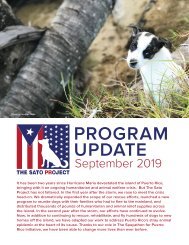Celebrating 10 Years of The Sato Project
When The Sato Project was founded in 2011, our work began by rescuing one dog at a time from Dead Dog Beach. 10 Years later we have flown and vetted over 6,000 dogs from the streets and beaches of Puerto Rico to loving homes on the mainland. We have also spay/neutered and vaccinated over 7,500 animals and distributed 136K lbs of disaster relief supplies across the island in the wake of Puerto Rico's multiple natural disasters. None of these accomplishments would have been possible without the support of our #satostrong community. Read this special edition 10th Anniversary Program Report for The Sato Project's full story.
When The Sato Project was founded in 2011, our work began by rescuing one dog at a time from Dead Dog Beach. 10 Years later we have flown and vetted over 6,000 dogs from the streets and beaches of Puerto Rico to loving homes on the mainland. We have also spay/neutered and vaccinated over 7,500 animals and distributed 136K lbs of disaster relief supplies across the island in the wake of Puerto Rico's multiple natural disasters. None of these accomplishments would have been possible without the support of our #satostrong community. Read this special edition 10th Anniversary Program Report for The Sato Project's full story.
You also want an ePaper? Increase the reach of your titles
YUMPU automatically turns print PDFs into web optimized ePapers that Google loves.
AN ISLAND IN PERPETUAL CRISIS
PUERTO RICO’S ONGOING CHALLENGES TODAY
From January 1, 2020 to September 1, 2021, Puerto Rico registered 9,624
earthquakes of a 2.0 magnitude or higher.
When The Sato Project was founded in 2011, Puerto Rico’s
economy was already in the midst of a decades-long
recession. Along with this, there was a steady decline in the
population as residents migrated to the mainland U.S. for
better economic opportunities. According to U.S. Census
data, Puerto Rico lost a ninth of its total population from
2010 to 2020, the largest drop of any state or territory
counted in the census.
Due to years of underfunding and mismanagement, Puerto
Rico’s economy, infrastructure, and population were already
vulnerable when Hurricane Maria devastated the island.
Four years later in 2021, the reconstruction and recovery
effort is still far from over. Power outages and water supply
cutoffs remain constant occurrences and thousands of
houses are yet to be rebuilt. In the immediate months after
the storm, the Federal Emergency Management Agency
(FEMA) distributed blue tarps as ‘temporary’ replacements
for destroyed roofs. These tarps remain installed and highly
visible in communities all over the island. It is estimated that
as many as 750,000 Puerto Ricans are still living in homes
that have not been repaired since Hurricane Maria made
landfall. This means that every time there is a new hurricane
warning, tropical storm, or even light rain, Puerto Ricans
know that they have to prepare for the worst: flooding,
landslides, sewage blocks, power outages and more. Until
vital infrastructure is repaired, this is the daily reality of our
organization and the residents of the island.
The island was met with another crisis at the end of 2019.
On December 18th, 2019, a series of small earthquakes
began rattling the island on a daily basis. On the morning of
January 7th, Puerto Ricans were jarred awake by a deadly
6.4 magnitude earthquake - the largest to shake the island
in at least 100 years. Power was lost again, more homes
collapsed, and 8,000 people became displaced. Thousands
more started sleeping outside, because they were too afraid
that their houses would collapse on top of them during the
night. Little did we know that this was only the beginning.
While none have been as devastating as the first 6.4
magnitude earthquake, smaller earthquakes have continued
on nearly a daily basis throughout all of 2020 and 2021.
12





